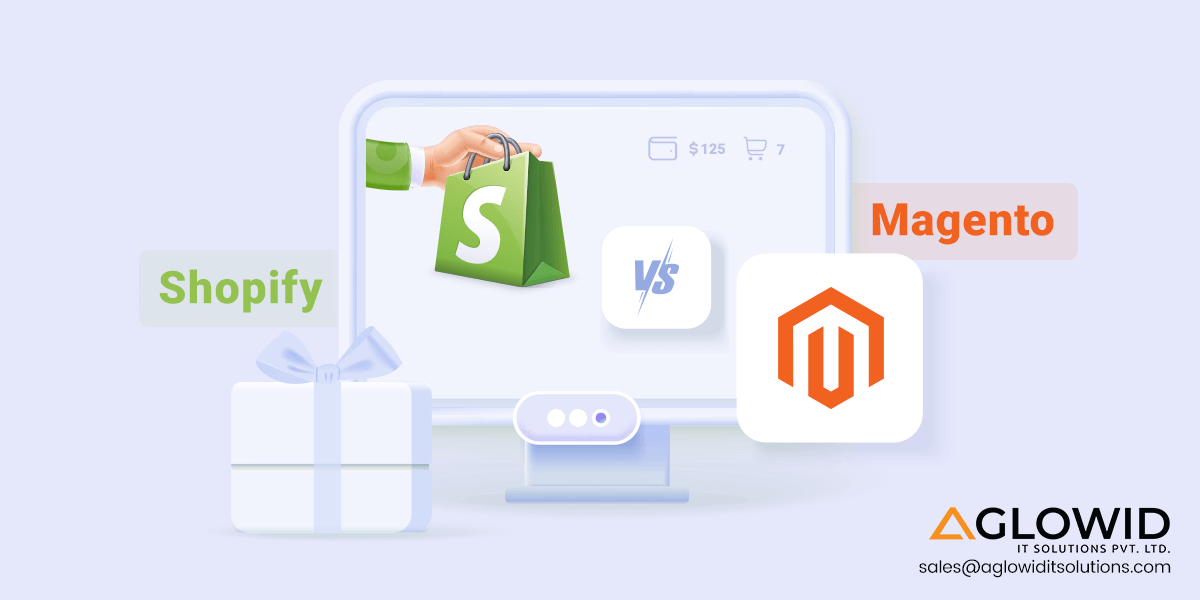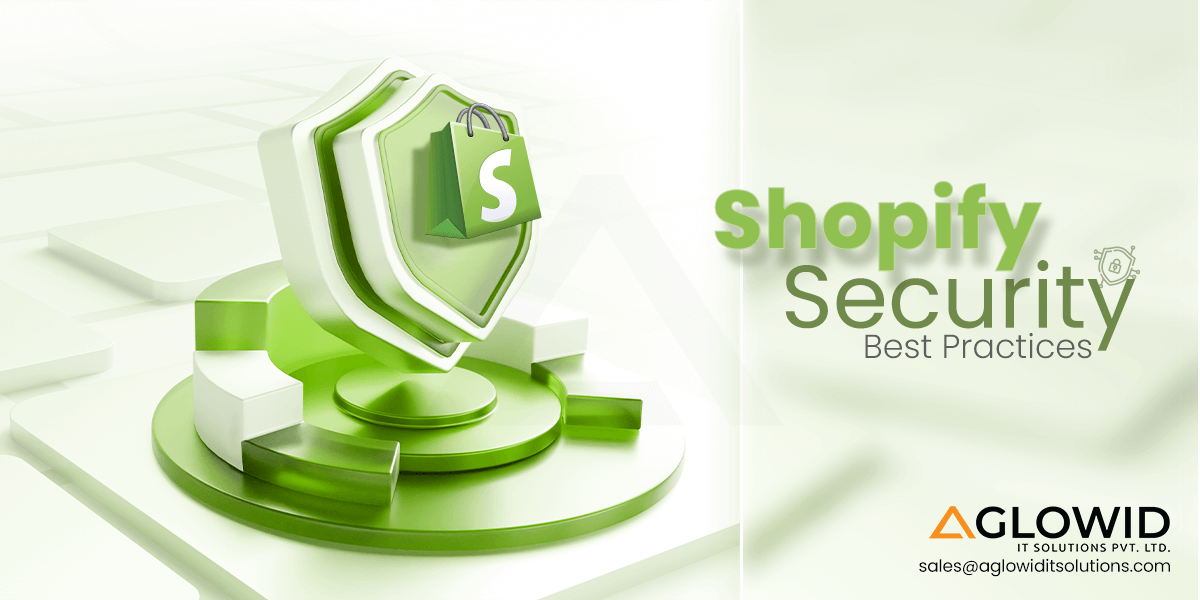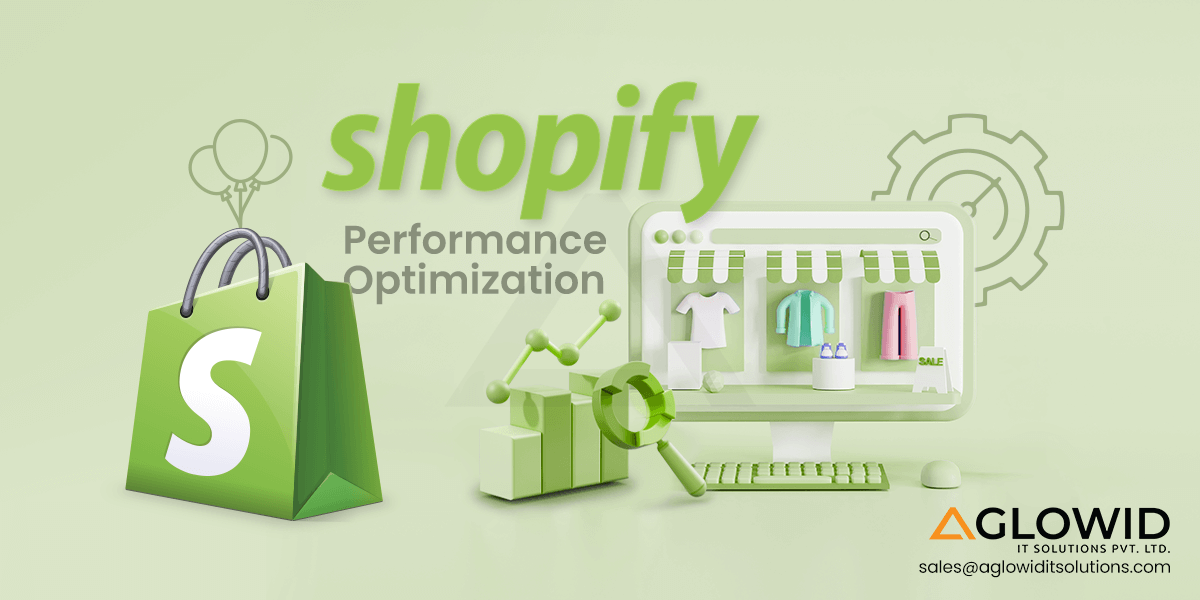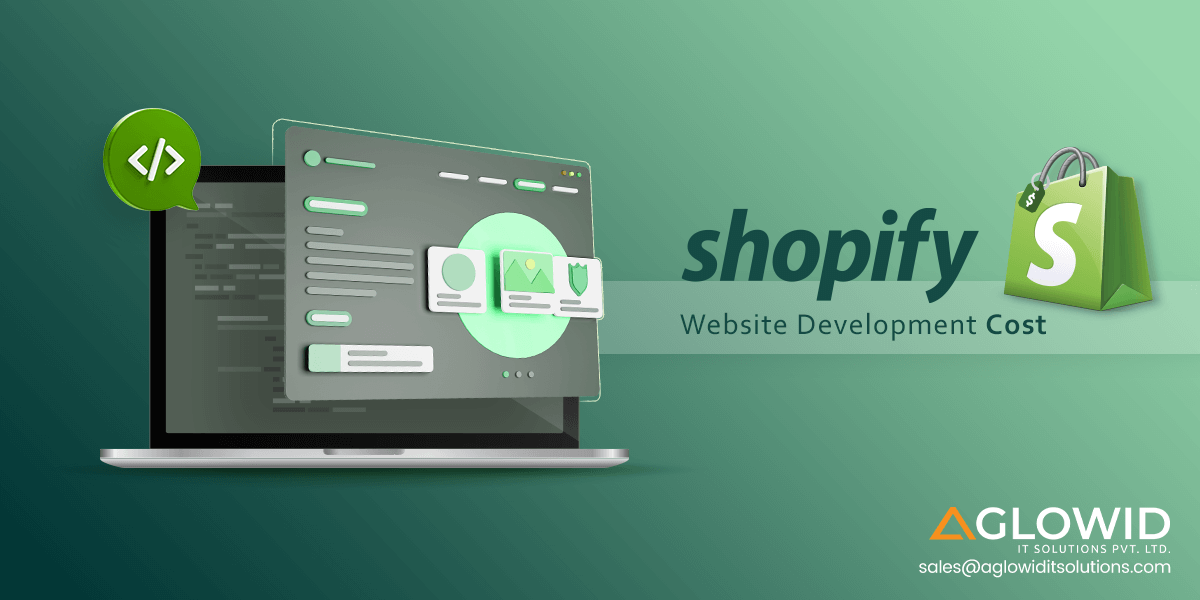Quick Summary:
Consider creating an online store, do you? Or do you intend to switch the platform where you’re working on your e-commerce project? Well-known e-commerce solutions like Magento and Shopify are used to build online stores. Selecting the ideal platform for your e-commerce website might be challenging because platform development offers many possibilities. You may use this blog to compare Magento with Shopify and make an informed conclusion. The different features, adaptability, costs, and other aspects of both platforms will be discussed.
Considering that you’re soon going to create an e-commerce website or move your current store to a different platform, Current popular platforms for creating and managing eCommerce stores include Shopify and Magento open-source. The difficult task of selecting the best e-commerce platform for every online business. The two most well-known website building tools nowadays are Magento and Shopify, both used for online stores. Before beginning your e-commerce, it is vital to select a good platform.
Depending on the foundation of your website platform, your online store will either succeed or fail. For the development, administration, and upkeep of an online business, choosing the best eCommerce platform is vital. This element may significantly influence your company’s performance.
Since SMEs operate on tight budgets and resources, this is particularly crucial. On this website, we describe a wide range of eCommerce platforms. When it comes to more significant, more complex e-commerce sites, Magento is the leading competitor. At the same time, Shopify has somewhat of a stranglehold on the “hosted, all-in-one” platform market. Although they are incredibly different systems, we want to compare Magento and Shopify to find which one is best for your company.
But before you make any decision based on comparing the two systems, you should be fully aware of specific significant underlying differences between them. Before delving into their differences, let’s look at each of them from a high level.
Magento vs Shopify: Overview
Although both platforms provide distinctive e-commerce store experiences, they are very different in practically every way, including their target consumers. Let’s look at both of them in general.
What is Magento?
An open-source shopping cart called Magento eCommerce was created with the MVC architecture and Zend framework. Adobe Inc. acquired Magento in May 2018 for $1.68 billion. The platform is solidly constructed to handle front-end and back-end development successfully.

The Community Edition and Enterprise Edition are the two editions of Magento. The eCommerce platform can be customized by developers, who can change the code to suit their needs. It permits the use of cutting-edge techniques and pre-built features to create quick and performance-focused websites. It comes with no-cost Magento website creation features. Along with all of this, Magento makes it simple to customize shopping carts, goods, brands, and much more.
Key Features of Magento
- Reporting & Analytics
- Product Browsing
- Customer Accounts
- Order Management
- Payment & Shipping
- Marketing & Promotional Tools
- Search Engine Optimization

Some interesting facts about Magento
- Magento was included in the top five shop software providers in the United States in 2020
- Magento is downloaded nearly 5,000 times every day
- 11,000 e-stores currently run on Magento 2

What’s Shopify?
Shopify was established by Tobias Lutke, Daniel Weinand, and Scott Lake in 2004. Insight Partners, OMERS Ventures, and other investors have contributed more than $122 Million to the company throughout four fundraising rounds. Shopify has purchased twelve businesses, including Oberlo, Return Magic, handshake, Boultmade, and many more.

Businesses can launch online eCommerce stores using the Software-as-Service solution known as Shopify. Shopify specializes in developing, hosting, operating, and managing websites for the eCommerce sector, in contrast to WordPress and Blogger. Most small and medium-sized organizations worldwide utilize this as their primary multi-channel content management system.
It provides a wide range of tools to meet every need of an online store, including Shipping, customer engagement, marketing, and sales. For users to better grasp the platform, Shopify also offers a 15-day free trial period. Users can access a massive library of pre-built templates that they may utilize to create unique websites depending on the market niche.
Key Features of Shopify
- Shopify POS
- SEO Tools
- Shopify Dropshipping
- Shopify Analytics
- Abandoned Cart reminders
- Top-notch support
- Exceptional Security
- Store Management

Some interesting facts about Shopify
- As of March 2022, Shopify has a 6.6% market share of all websites using a CMS
- In 2020, Shopify earned over $319 Million in net income

Also Read : Shopify Setup Checklist for your eCommerce Store
Shopify vs Magento: Pros n Cons
Let’s begin with a brief overview of the pros and cons of each option, comparing Magento vs Shopify. Considerable benefits of Shopify vs Magento exist for both, but there are also some areas where they might fall short for your eCommerce website.
Shopify Pros
- Tons of beautiful responsive store themes
- A Comprehensive eCommerce builder
- Great app store for extending the functionality of your website
- Robust customer support
- Ease of use
- Various checkout & Payment options
- A large community of dedicated developers
Shopify Cons
- Most themes have a price attached to them
- Integrating apps into your store makes it more complex
- There’s a fee for every transaction (unless you use Shopify payments)

Magento Pros
- Excellent community with tons of support for user
- Platform Flexibility along with tons of customization options
- A good range of themes to choose from
- 24*7 customer support
- Open-source & free to use
- Allows Magento 2 extension
- User friendly
Magento Cons
- Steep Learning curve
- Difficult for beginners
- Time-consuming for setup
- Expensive

Knowing the differences between Magento and Shopify and their advantages, you can make a more informed decision. Let’s examine the comparison of Magento and Shopify.
Head-to-Head Comparison Between Shopify Vs Magento
Now that you have an overview of both technologies let’s look at the tabular comparison between Shopify and Magento to grasp the differences.
| Factors | Shopify | Magento |
| Developers | Tobias Lütke, Daniel Weinand, Scott Lake |
Magento, Inc. |
| Initial Release | 2006 | 2008 |
| Type | E-Commerce | CMS & Shopping cart software |
| Dropshipping
|
Obrelo, a portal that aids in finding products from various providers, may be integrated into Shopify to drop ship. | A Magento add-on called Dropship enables online retailers to start selling products from Ali Express, which cost about $249. |
| Coupon Provision | Except for the Lite plan, every plan includes this functionality. | From the beginning, Magento enables the design and calculation of discount codes. |
| Bilingual Skills
|
Shopify has paid/third-party apps available for this. By default, it does not provide complete multilingual functionality. | linguistic versatility |
| Currency | Shopify store owners can sell in 133 different currencies. | Magento supports more than 200 other currencies. |
| Salary | $105,848/yr | $89,985 /yr |
| Jobs Availablity | 50,891 Jobs available | 25,078 Jobs available |
Magento vs Shopify Comparison Guide
Although both the platforms offer a wide range of features and functionalities that improve the store performance and boost your sale, there are significant differences between these platforms. Let’s look at some of the key Shopify vs Magento comparisons.
Magento vs Shopify: Performance
Due to its resource requirements, Magento needs a stable hosting environment. It is well known that a merchant’s hosting infrastructure may begin to feel the burden as more product SKUs are introduced. With more than a decade of experience, Magento provides a caching-based optimized solution to enhance site performance. There is no other place to find the answer.
On the other side, Shopify is a slim application. Since it can support more product SKUs on the same hardware that can only support a smaller Magento store, it performs rapidly in most settings. However, Magento offers more features than Shopify provides.
If the server is correctly set up, Magento will function without any issues. Magento was used by 64% of our hosting solutions in 2018. The two main reasons retailers chose Magento were uptime and functionality, demonstrating the importance of performance.
Magento is the performance champion due to its additional functionality, while Shopify only needs a little tweaking. It’s nearly likely that a Magento eCommerce business would perform better in terms of ROI by providing tailored consumer experiences.
Also Read : Why & How to Turn your Shopify Store to Mobile App?
Magento vs Shopify: Pricing
Magento comes in three editions:
- Magento Open Source:– free to install, but you’ll need to pay for hosting
- Magento Commerce:– it starts at $22,000 per year
- Magento Commerce Cloud:– it starts at $40,000 per year (includes hosting)
Shopify is an all-in-one solution. It offers 14-day free trials and works with three monthly offerings at different prices for different user needs, which include:
- Basic Shopify Plan:- $29 per month + 2.9% and 30¢ per credit card transaction
- Shopify Plan:- Costs $79 per month + 2.6% and 30¢ per credit card transaction
- Advanced Shopify Plan:- Costs $299 per month + 2.4% and 30¢ per credit card transaction
- Shopify Plus:- Costs $2000 per month + 2.15% per credit card transaction
In Search to Hire Shopify Developers?
Hire certified dedicated Shopify developers From Aglowid to build a robust, scalable, and user-friendly eCommerce store.
Magento vs Shopify Popularity
Popularity is one of the most important things for every technology. The same goes for Magento and Shopify. Let’s take a look at the popularity of both these technologies.
Google Trends for Magento and Shopify
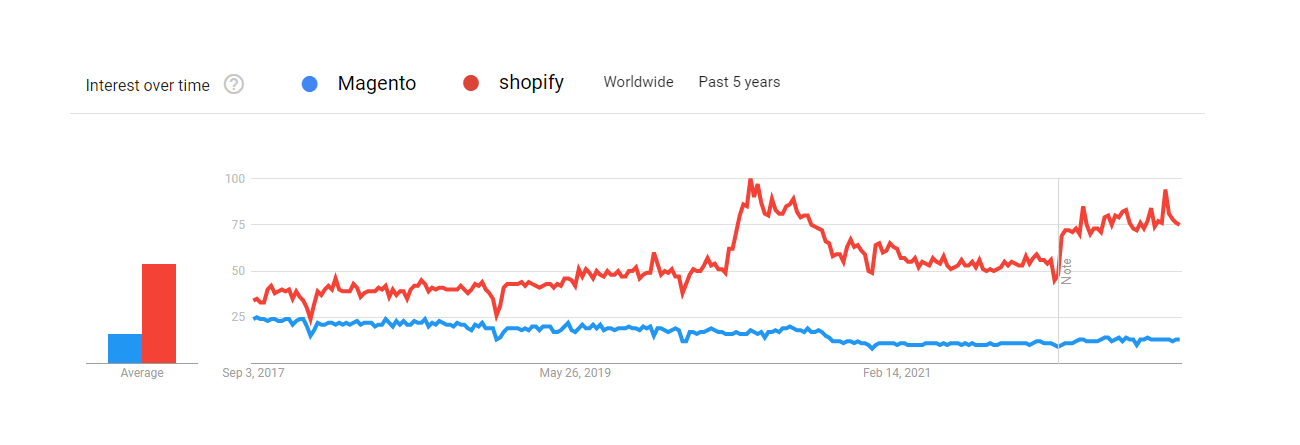
The graph of google trends shows the data for the last 5 years for both the technology where blue color represents Magento whereas red color represents Shopify. You can see a decrease in Magento’s popularity and a sudden rise in Shopify. This graph represents the average queries asked about both the technology in general. Magento generates an average of 16 questions, whereas Shopify generates 54 queries.
SimilarTech Data
According to the SimilarTech report, there is a rising Shopify trend and a fall in the Magento trends. Shopify has 543,364 live websites, whereas Magento has 93,278 live websites.

Shopify Vs Magento Market Share
Statista
According to Statista’s eCommerce platforms market share worldwide, Shopify takes fourth place with 10% of the market share, whereas Magento secured 7th position with 1.72% of the market share.
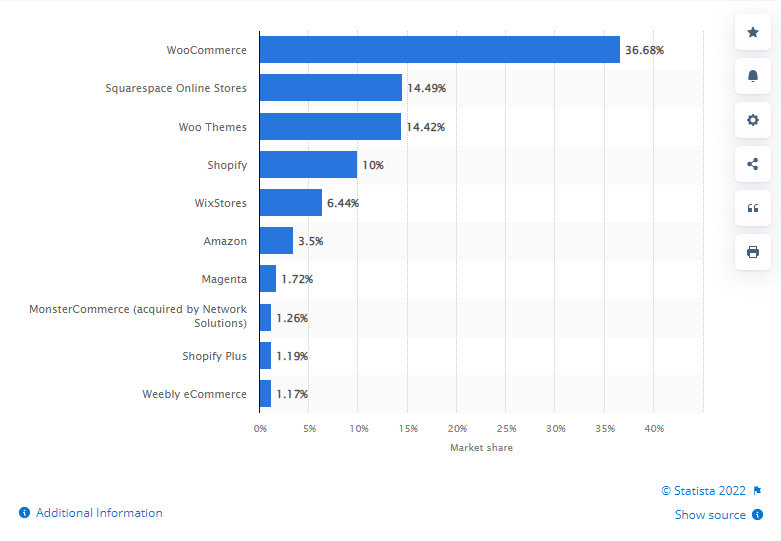
Similar Tech Data
According to SimilarTech, look at the market share by Top Websites, Websites Category, and Geography.
Marketshare by Top Websites
Shopify is leading in the Top 10K sites with 1.52% of the market share, Top 100K sites with 2.02%, and Top 1M sites with 4.128% of the market share. As for the entire web, it has 0.771% of the market share. When talking about Magento, it can be seen that it is lagging with the Top 10K sites with 0.3% of the market share, Top 100K sites with 0.816%, Top 1M sites with 1.234% of the market share, as for the entire web, it has 0.133% of the market share.
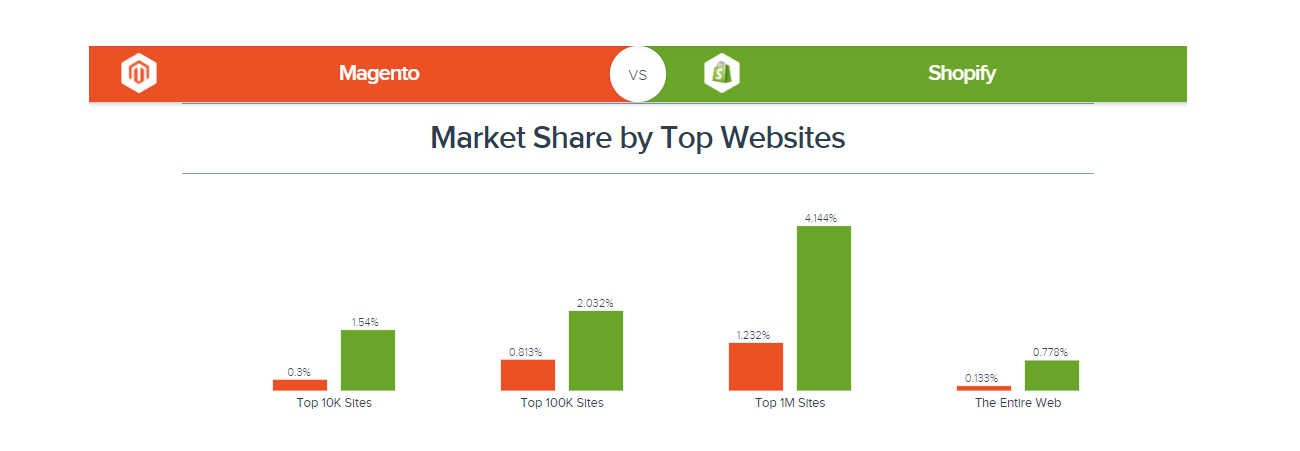
With Website Category
Shopify has better usage coverage in more website categories. Including Lifestyle, Computers, Electronics & Technology, Food & Drink Sports, and 19 other types. While talking about Magento, it is Heavy Industry & Engineering.
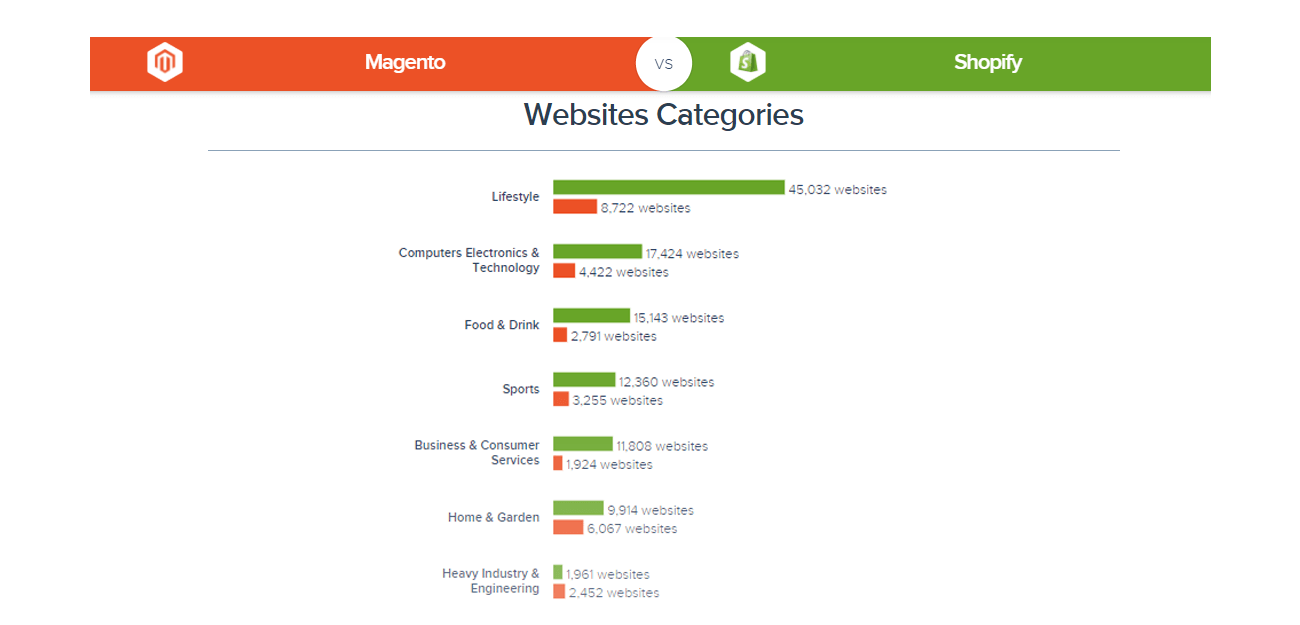
With Geography part
While talking about Geography, Shopify leads in countries including the United States, United Kingdom, Canada, Australia, and 158 other countries, whereas Magento is leading in Andorra, French Guiana, Turkmenistan, and Gabon.

Magento vs Shopify: Themes & Templates
How their platform will look is one of the first considerations for many businesses, following concerns with cost and use. Consequently, a customer’s first impression is quite crucial. Your beautiful brand and unique personality can be reflected through themes. Compare Magento with Shopify’s themes now!
Shopify Themes
Shopify offers many themes, including 73 premium and 13 free options. Even at this pricing, some consumers may find these a bit pricey, considering that Shopify owners must spend between $150 and $350 on a theme for their captivating storefronts.
Features
- Shopify Themes allows the drag-and-drop editor to add, remove, resize or switch elements
- All of these themes are mobile-optimized
- Easy to create new pages or add pages
- According to your business, you can change the color palette and images
- This theme also lets you add social media to its feed
Magento Themes
Six fully mobile-responsive Magento themes are available for as little as $99 and as much as $499. Even from the start, you can develop themes with Magento (but this needs you to have deep coding knowledge or a budget big enough to hire help).
Features
- With firm technical knowledge, Magento allows flexible customization
- To make your store engaging, you can add animations
- Add a featured product slider to your homepage
- You can include newsletter options in your webpage footer
- Place “cross-selling blocks” on your product pages
Shopify vs Magento: SEO
SEO, which stands for search engine optimization, enables you to improve the SEO of your eCommerce website because it will influence how well your store ranks. Both shopping carts in the Magento vs. Shopify comparison offer choices in this area that are pretty comparable.
You can quickly change the page title, description, and alt text for photos to make it easier for search engines to comprehend what they are about on both Shopify and Magento SEO. To improve the Google ranking of your online store, for instance, you might look at this Magento SEO advice.
A robust collection of marketing tools are included with both Magento and Shopify to help you advertise your online business. To promote your products and provide information, Shopify has an integrated email tool. A ton of gorgeous email templates are included in this application that you may edit while still looking professional.
Shopify vs. Magento: Ease of Use
Web designers and developers aren’t most e-merchants launching an online business. Even consumers who understand the fundamentals desire a simple platform to set up and use. Examining the usability differences between Shopify and Magento will be helpful.
Magento Ease of Use
For non-tech users, in particular, Magento is not as user-friendly as Shopify in terms of usability. Although this platform offers total control over a user’s website, installing and setting up an online company on it necessitates a thorough understanding of technology.
Shopify Ease to use
In contrast, Shopify has the upper hand over Magento. This eCommerce solution is straightforward because of the nature of a hosted platform. Shopify is also designed for everyone, including tech-savvy and those with some background in it. Users of Shopify will therefore have little trouble setting up their stores.
Shopify Vs Magento: Security
Security is essential when operating an internet business. In actuality, thousands of websites are hacked every day. You must ensure that the most significant security plugins and upgrades are being utilized on your website if you want to prevent security gaps. A set of guidelines called PCI Compliance applies to businesses that process online payments. For online retailers, maintaining PCI compliance is expensive and time-consuming.
Interesting Shopify comes with SSL encryption and Level1 PCI DSS compliant, which helps your site automatically be protected. It’s interesting to note that Shopify comes standard with Level 1 PCI DSS compliance and SSL encryption, which allows you to save your website automatically. Additionally, this platform is a fantastic resource for e-commerce companies to handle customer data sensitively throughout a consumer’s interaction with store websites.
You have the freedom with Magento to make your security changes to the website. Though Magento’s security is robust, you must adopt a more hands-on approach to adhere to PCI compliance properly. To keep you safe, Magento routinely releases updates and patches. Additionally, you can easily install security extensions to Magento 2 to protect your valuable data.
Magento vs Shopify: Flexibility & Scalability
It is critical to consider if the platform you choose for your project will be able to meet your long-term business objectives.
Flexibility & Scalability Shopify
Scaling with Shopify entails upgrading to a more expensive price plan. For a monthly cost of $299, Shopify Advanced offers the most tools for growing your store. But even this strategy has scalability issues. You’ll know you need to relocate when your business has more than 8 storefronts (the maximum supported by Shopify), and you’re sick of paying steadily rising costs for payment transactions (especially those made from outside the country). Flexibility is comparable. Even with a skilled IT team, Shopify has limitations, and there is little you can do to customize it further.
Scalability & Flexibility Magento
Although you’ll need to contact the IT team, Magento’s scalability is unrestricted. More items, more consumers during the busiest times, and even worldwide growth will be no problem for you. The open-source Magento platform allows for some customization.
Shopify vs Magento: Payment gateways
Shopify has an in-house payment processor, but apart from that, it also supports PayPal, Stripe, Authorize.Net, SagePay, AliPay Global, 2Checkout, PayFast, PayGate, WorldPay, PxPay, and Skrill as its payment gateways.
- Basic Shopify:- 9% + $0.30 per transaction
- In-person Payment:- 7% + $0.00 per transaction
- Shopify:- 6% + $0.30 for online and 2.5% + $0.00 for in-person
- Third-Party Payment Gateways:- charge 2% on each transaction
Magento integrates with PayPal, Braintree, Stripe, Authorize.Net, and Amazon Pay as payment gateways. For a better understanding of the things, we have done a breakdown.
Here is the fee breakdown for Magento:
- Magento Open Source:- 9% + $0.30 per transaction
- Magento Commerce:- 9% + $0.30 per transaction
- Magento Commerce Cloud:- 9% + $0.30 per transaction
Also Read : Top Shopify Apps for your eCommerce Store
Magneto vs Shopify: Apps & Extension
Adding extra functionality to your online platform is essential, especially if the platform’s in-built features aren’t enough. Shopify and Magento enable you to install apps, extensions, and add-ons easily. For areas such as Shipping, social media advertising, and email marketing. Shopify’s App Store contains over 1200 apps, both free and premium.
Magento Marketplace has over 5000 extensions, and 1,970 of those are free. 10% of the paid options cost around $30, while other extensions can cost up to $2000. The prices can vary depending on the development agency that created them and whether you’ll need an expert installing them.
Shopify vs Magento: Updates & patches
In contrast to Magento, which requires manual updating, Shopify administers patches and upgrades for its users. Although Magento’s approach necessitates a more significant time commitment from the developer team or retailer, it also offers more flexibility.
The great community of eCommerce developers and contributors within Magento is essentially to thank for this. Dedicated security updates for Magento are regularly released as a result of ongoing testing and development by a group of developers who know about the needs of eCommerce stores.
On the other hand, the only people in charge of Shopify are employees. The resources available to develop and implement remedies for security issues are significantly reduced. The repairs are handled internally, although Shopify has a bounty program that pays users who discover flaws.
Adobe Magento Vs Shopify: Sales Tools
These two platforms are no different from other technologies in having many tools available. In a comparison of Magento vs. Shopify, each forum has special tools that let businesses streamline their online sales.
Following are some of the best Magento sales tools available in the market.
- Complete customization on a single page of the checkout
- Shipping costs in real-time from ups, ups XML (account rates), FedEx (account rates), USPS, and DHL
- Multiple addresses can be delivered in one order
- A persistent shopping cart stores products that haven’t been purchased for the customer’s next visit
- Create adaptable coupons for specific retailers, customer segments, timeframes, items, and categories
- Feature free shipping choices
- Add links for sharing products on Facebook, Twitter, and Email
And few of the Shopify tools include:
Sell using various online sales channels, such as your website, the Shop app, Instagram, Facebook, and Handshake.
- When a consumer leaves a store without finishing the process, abandoned checkout recovery (acr) automatically emails that customer
- Set sale prices for certain products, automatic discounts, or discount codes
- In-the-moment carrier shipping rates
- A sophisticated consumer reporting system that identifies risky and devoted customers
- Fraud detection built-in
- Using the Shopify admin interface, create manual orders
A large variety of integrated sales tools are available as standard with both Magento and Shopify. However, you must increase your Shopify plan or buy more extensions from the Magento Marketplace if you want more sophisticated capabilities.
Shopify vs. Magento: Customer Support
Any e-commerce platform must include customer assistance. Magento and Shopify give retailers several ways to receive the service they need to solve typical problems and build creative online stores. Shopify offers client assistance through:
- Help center for Shopify
- Forums for Shopify users
- Tutorial videos
- Webinars
- Support is available 24 hours a day via phone and live chat
- Buyify changelog
In-depth user guides written by Magento developers, a knowledge base for community support, and training videos are just a few of the customer support tools that Magento offers retailers. However, unlike Shopify, which has a dedicated support crew, Magento is an open-source platform so that retailers won’t have that luxury.
Magento 2 Vs Shopify Plus
Even though both Shopify Plus and Magento are built to manage enterprise-level eCommerce retail, the critical distinctions between the two can make or break your company’s chances of success.
The company’s enterprise-level platform, Magento Commerce 2, is currently in its second iteration and has been a top choice for major corporations since its initial release in 2016. The ability to customize and handle many stores is why companies choose Magento Commerce 2.
Since its inception in 2014, Shopify Plus has gained popularity among enterprise and mid-level companies wishing to expand. The platform is renowned for being simple to use, having a rapid time to market, and having a Shopify API enabling third-party apps’ integration.
Magento vs. Shopify: Popular Websites Using Both Technologies
Selecting the right platform for your tech stack is vital for any eCommerce success. Following are some popular websites using Magento and Shopify in their tech stack.
Magento
- Foxnews
- Mytheresa
- Asus
- LG
- Vmware
- Blondieshop
- Cosmopolitan
- Royalmail
- Caranddriver
- Indusind Bank

Shopify
- CNN
- W3schools
- Hulu
- Forbes
- Washingtonpost
- Coingecko
- Nypost
- Breitbart
- Crunchyroll
- Merriam-Webster
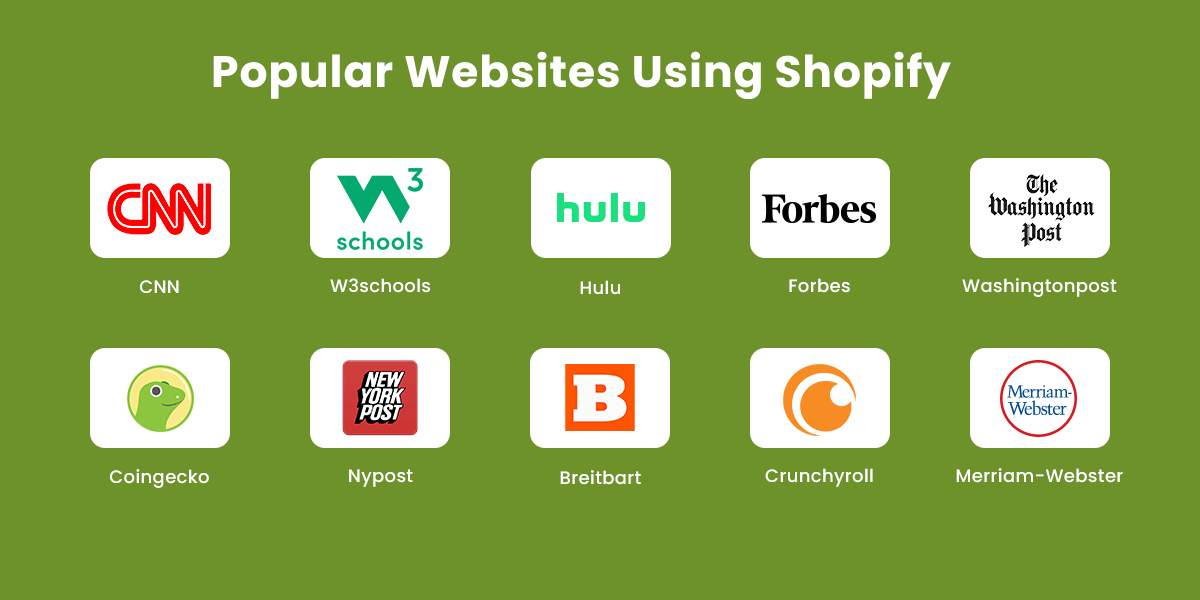
Shopify Vs Magento: Wrapping up!
Since Shopify is a hosted and managed service, it is easier to use than Magento. It is free but needs you to buy hosting and carry out all the software/system setup and installation procedures. Only moderately tech-savvy persons (and not typical end-users) would be able to do this.
You should use Shopify:

- You want to open your store as soon as feasible
- You now use an e-commerce website builder (such as Wix, Squarespace, or Weebly), but you want to upgrade to a more capable one
- You’re just starting with e-commerce, but you want to grow it into a full-fledged business
- You would appreciate the ease of a single payment and the availability of a support team
You should use Magento:
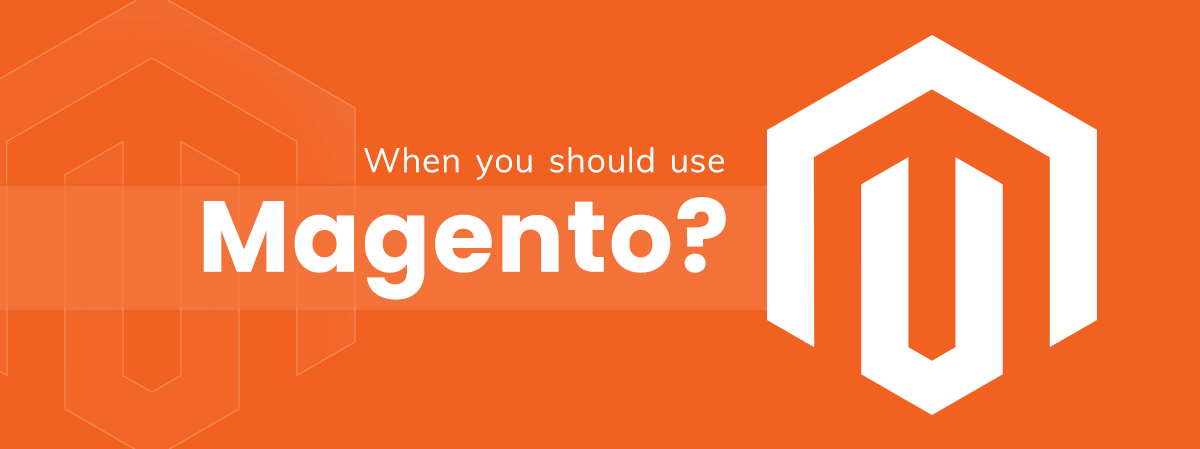
- If you are proficient in coding and want to create an online store for your medium- or enterprise-level organization
- Through coding, you wish to have complete creative freedom
- A global presence already exists for you
- When you intend to devote time and money to grow the project and when you want to create a large brand with significant revenue
But in the end, it all boils down to your business requirements. You need to be clear about the features & functionality that you want in your project before selecting any technology.
have a unique app Idea?
Hire Certified Developers To Build Robust Feature, Rich App And Websites.
